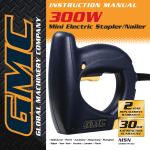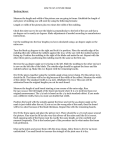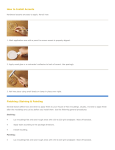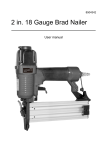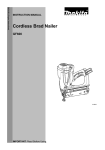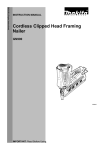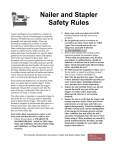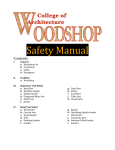Download AIR DRIVEN FASTENING TOOLS
Transcript
AIR DRIVEN FASTENING TOOLS SAFETY AND OPERATING MANUAL INDEX A) SAFETY RULES 1) PERSONAL PROTECTIVE EQUIPMENT 2) COMPRESSED AIR SUPPLY 3) FASTENERS 4) TOOL PRE-OPERATION CHECK 5) GENERAL TOOL OPERATION 6) TOOL OPERATION / APPLICATIONS 7) SPECIAL DEVICES B) ACTUATION SYSTEMS C) TOOL USE 1) PRELIMINARY OPERATIONS 2) LOADING MODES 3) JAM CLEARANCE D) TECHNICAL FEATURES AND ACCESSORIES E) AIR SUPPLY CONNECTION F) MAINTENANCE G) SUMMARY TABLE of some problems and their remedies 1 Air driven fastening tools have been designed according to the European Standard prEN 792-13 and the American ANSI SNT-101-1993. A) SAFETY RULES Before attempting to load, handle, operate, adjust or service the tool, all tool operators and their immediate foremen must carefully read and become familiar with all safety precautions, operating instructions and tool labels. Always follow appropriate safety and operating precautions, and make sure bystanders and others in the work area are wearing all required personal protective equipment whenever the tool is being used. Do not use the tool if you do not understand these instructions. Do not use tools without WARNING and/or DANGER labels on tool. If label is missing contact local distributor, the Manufacturer (see back of this manual), or call the Customer Service Desk for assistance. 1) PERSONAL PROTECTIVE EQUIPMENT WEAR ALL REQUIRED PERSONAL PROTECTIVE EQUIPMENT NECESSARY FOR THE JOB TYPE AND APPLICATION BEING PERFORMED. Failure to wear necessary personal protective equipment may result in serious personal injury to tool operator, bystanders and others in the work area. 1.1) ALWAYS WEAR APPROVED SAFETY GLASSES (OSHA, ISO, EN) with side shields or other approved front and side eye protection such as goggles, when handling, operating or servicing the tool, or when working in the area where the tool is being operated. Failure to wear approved complete eye protection can result in serious injury from flying splinters, fasteners or other debris. 1.2) WEAR HEARING PROTECTION when operating or working near the tool. Constant or repeated unprotected exposure to noise may cause permanent hearing loss. 1.3) WEAR APPROVED HEAD PROTECTION whenever working in an area where overhead work or the operation of other pneumatic fastening tools may pose a potential overhead hazard. Head protection should also be worn when working around scaffolding, elevated work platforms, ladders, or any other work platform that is elevated and poses a risk of injury from falling items or the operation of hand and power tools. Failure to wear approved head protection can result in serious head injury from falling tools or work materials, flying fasteners or debris, or direct head contact with power tools. 2) COMPRESSED AIR SUPPLY 2.1) NEVER USE COMPRESSED OXYGEN, FUELS OR OTHER GASES. Use only clean, dry regulated air to power the tool. The use of anything other than compressed air may cause the tool to explode, causing serious or fatal injuries to the tool operators and others in the work area. Tool shall not be connected to air source that potentially exceeds 200 psig of 13,7 bar. 2.2) NEVER EXCEED THE MAXIMUM RECOMMENDED PRESSURE for the tool. Make sure the air compressor pressure gauge is working properly, and check it frequently to make sure air pressure is properly set. Exceeding the maximum recommended air pressure can result in severe overdriving or pass-through of fasteners, and premature failure of tool components, and result in injury from flying fasteners or other debris. 2.3) Make sure MINIMUM AIR PRESSURE delivered to tool is ADEQUATE to drive fasteners being used. Allowing tank pressure to run down to a pressure lower than that needed to drive a fastener can result in increased tool recoil. 2.4) USE ONLY A MALE FREE FLOW TYPE of pneumatic quick-disconnect coupling on the tool, so that no compressed air is trapped inside the tool housing when the air hose is disconnected. Never use a female coupling, or any other type of fitting that prevents air in the tool housing from being discharged when the air hose is disconnected. Trapping air inside the tool may permit the tool to unexpectedly discharge an additional fastener after the air hose is disconnected, resulting in serious injury to tool operator, service personnel or bystanders. 2.5) HOSES AND FITTINGS must have a minimum working pressure rating of 150 psig (10.3 bar) or 150% of the maximum pressure, whichever is higher. Normal wear and tear can weaken hoses and fittings, and cause premature failure and sudden air pressure drops, resulting in increased tool recoil. 3) FASTENERS 3.1) ALWAYS USE FASTENERS of the type, dimensions and tolerances SPECIFIED FOR THE TOOL model being used. Using incorrect or improperly sized fasteners can cause jamming, cutting or separation of the fastener head, and/or loss of fastener control during driving, and result in risk of injury from flying fasteners or fastener debris. Contact the Customer Service Desk for assistance for the location of your nearest authorised fastener distributor. 3.2) ALWAYS CHECK THE TOOL FOR FASTENERS BEFORE RELOADING when changing fastener sizes. Using the wrong fastener length can cause increased tool recoil, excessive work piece penetration and splitting, the possibility of complete fastener pass-through, and result in injury to operator and bystanders from flying fasteners or other debris. 4) TOOL PRE-OPERATION CHECK 4.1) CHECK THE TOOL BEFORE USING to make sure cap and nose screws are tightened securely. Air leakage may result in loss of drive force and increased tool recoil. 4.2) CHECK THE OPERATION OF TRIGGER AND WORK CONTACTING ELEMENT to ensure that it is working correctly: a) Always assume the tool contains fasteners. Tool may eject a fastener when connected to air supply; therefore, remove all fasteners from tool before connecting air. b) With tool still disconnected, make daily inspection to assure free movement of trigger. Do not use tool if trigger sticks or binds. Never clamp the trigger in a locked or operating position. c) Connect empty tool to air hose and fully depress the work contacting element against a safe work piece without holding trigger. Tool must not operate. d) Point empty tool in a safe direction, and squeeze trigger. Tool must not operate. e) If tool operates during above testing, disconnect the tool immediately and obtain service from your local distributor. ∇) at the bottom of the tool body near the nose. A work contacting element allows the tool to be Tools with a work contacting element are marked with a raised triangle (∇ operated only after the muzzle is pressed against the work piece. Do not use a tool with a work contacting element that: sticks or binds, is damaged or has been tampered with. 5) GENERAL TOOL OPERATION 5.1) NEVER HOLD, TRANSPORT OR OTHERWISE CARRY THE TOOL WITH THE TRIGGER DEPRESSED. Disconnect the tool from the air supply if the tool must be moved to a new fastening location. Accidental or unintentional contact with the safety while the trigger is depressed may cause an unwanted or unexpected fastener discharge, resulting in serious injury to operators or others. 5.2) NEVER DRAG A TOOL BY THE AIR HOSE. Dragging a tool by the air hose can weaken the tool housing and cause premature housing failure, or damage the hose, air fittings, and related components. Worn and weakened tool housings can rupture under pressure, resulting in serious injury to tool operator and others. 5.3) ALWAYS RELEASE THE TRIGGER COMPLETELY when the fastening operation has been completed, and do not contact or squeeze the trigger again until the tool is positioned on the intended work piece in preparation for the next fastening operation. Unintentional tool operation can result in injury to the tool operator or bystanders. 2 5.4) ALWAYS KEEP THE TOOL POINTED IN A SAFE DIRECTION away from others. Never assume the tool is empty. Always make sure that no one is in the potential path of a flying fastener, should the fastener break through the work piece and fly freely. A free flying fastener can cause serious injury or blindness to bystanders. No horseplay. Respect the tool as a working implement. 6) TOOL OPERATION / APPLICATIONS 6.1) NEVER OPERATE THE TOOL AT THE EDGE OF A WORKPIECE. The fastener can break through or miss the work piece and fly freely, striking bystanders. Free flying fasteners can also ricochet off of hard surfaces, causing injury to others. 6.2) NEVER DRIVE FASTENERS into extremely hard materials or directly on top of other fasteners. The tool may recoil, or the fastener could ricochet away from the intended work piece, causing injury to the operators or bystanders. 6.3) NEVER USE THE TOOL in the presence of flammable materials or flammable vapours. A spark from the tool could ignite the flammable substance, causing a fire or explosion and injuring the tool operator or bystanders. 6.4) ALWAYS GRIP THE TOOL HANDLE FIRMLY to maintain control of the tool, should the tool recoil unexpectedly. Allow the tool to recoil normally to prevent the tool from being actuated again on top of another fastener, or on an unsafe area or operator body part. 6.5) ALWAYS KEEP hands, feet and all other body parts AWAY from the area being fastened. A fastener can ricochet or follow the grain of the wood when driven, allowing the fastener point to exit the work unexpectedly and cause injury. 6.6) NEVER USE THE TOOL AS A HAMMER or impact device to position the workpiece. The sudden impact could shift inner components of the tool, resulting in a fastener discharge and injury to the operator and bystanders 6.7) NEVER MODIFY OR ALTER THE TOOL in any way. Unauthorized tool modifications may create hazardous tool operation, and result in injury to the tool operator or bystanders. 6.8) ALWAYS USE RECOMMENDED SPARE PARTS and accessories. The use of improper parts may create a hazard, and result in injury to the tool operator or bystanders. 6.9) ALWAYS DISCONNECT THE TOOL from the air supply when: loading and unloading, tool is unattended, performing service or maintenance, clearing a jam, relocating the tool and/or handing the tool to another person. Unauthorized users may attempt to operate the tool, injuring themselves or others. 6.10) ALWAYS MAINTAIN A FIRM STANCE and secure balance when operating the tool. Never overreach or attempt to operate the tool if a sudden recoil would result in loss of balance or tool control. 6.11) Fastener driving tools equipped with contact actuation, marked with the symbol “Do not use on scaffoldings, ladders”, shall not be used for specific application for example: - When changing one driving location to another involves the use of scaffoldings, stairs, ladders, or ladder alike constructions, e.g. roof laths, - Closing boxes and crates, - Fitting transportation safety systems e.g. on vehicles and wagons. 6.12) ALWAYS UNLOAD THE MAGAZINE WHEN FASTENING HAS BEEN COMPLETED and the tool has been disconnected from the air supply. Allowing fasteners to remain in the tool may result in the wrong size fasteners being used for the next fastening application to be performed. Using a tool with the wrong size fastener can result in an unexpected tool recoil, or splitting and pass-through of the fastener caused by over-driving of the fastener into the work. Unexpected recoils and free-flying fasteners can result in injury to the tool operator or bystanders. 6.13) Stands for mounting the fastener driving tools to a support for example a work table, shall be designed and constructed by the stand manufacturer in such a way that the fastener driving tool can be safely fixed for the intended use, thus for example avoiding damage, distortion or displacement. 7) SPECIAL DEVICES Tools equipped with special accessories or operating devices must be checked for proper configuration before being operated. Always make sure that all accessories and devices are functioning as indicated in the operating instructions for the device. Never attempt to operate a tool if you are unfamiliar with the type of accessory or device the tool is equipped with. Read the appropriate operating instructions, or call the Customer Service Desk for assistance. B) ACTUATION SYSTEMS Air driven fastening tools are available in a variety of operating modes to suit a range of operator preferences and application needs. All tool operators and their immediate foremen must fully understand the operating features of the actuation system type being used before attempting to operate tool. See the schematic view of the tool for cross-reference on each of the actuation systems described below: 1) Single actuation Single actuation allows a fastener to be driven each time the trigger is depressed, and requires no safety yoke to be activated. The trigger actuates the tool and must be squeezed each time a fastener is to be driven. No touch safety is present on this type of tool. This operating mode requires the immediate release of the trigger after each fastener is driven. 2) Single sequential actuation The trigger and the safety yoke have to be operated in such a way that one single driving operation is actuated via the trigger after the tool muzzle has been applied to the driving location. Thereafter, any further driving operation can only be actuated after returning the trigger to the starting position. The safety yoke does not need to be detached from the work plane. 3) Full sequential actuation Full sequential actuation prevents a fastener from being driven if the safety yoke is depressed while the trigger is being held in an activated position. In this mode of operation, the safety must be depressed against the work surface before the trigger becomes functional. When the safety is depressed, the trigger can be depressed, causing a fastener to be driven. The trigger and the safety must be released after each fastener is driven. When pressing again the safety yoke against the work piece without releasing the trigger first, or when keeping the safety depressed and the trigger is released and then depressed again, the tool does not operate. This sequence (depress safety / pull trigger / drive fastener / lift tool / release trigger) must be repeated each time a fastener is to be driven. This mode of operation is suitable for use in applications requiring precision placement of fasteners, applications involving confined areas or tight spaces that restrict manoeuvrability and prevent the operator from allowing the tool to recoil away from the work normally, or in applications where operators may need to change position frequently while making fastenings. It is also suitable for clinching operations, where the tool cannot be allowed to recoil and must be pressed down firmly against the work to clinch the fastener point. 4) Contact actuation Contact actuation permits “bottom-trip” or “bounce-fire” operation while the trigger is activated, or trigger-fire operation while the safety yoke is activated. 3 In this mode of operation, both the trigger and the safety yoke have to be actuated for each fastener to be driven, but do not have to be actuated in any specific order. When this mode of operation is being used, the trigger may be held in an actuated position while the safety yoke is placed in a series of successive fastener driving positions, using a bouncing motion that utilizes the recoil of the tool to help position the tool for each successive fastener driving operation. This mode may also be used for trigger actuation, but does not require that the trigger be released before the next fastening operation can be performed. Contact actuation is suitable for applications requiring rapid repetitive nailing operations without precise fastener placement, such as in fastening roof and floor decking, wall sheathing, and other applications where normal tool recoil can be easily controlled and used to help place the tool for successive fastener driving. 5) Continuous actuation In this mode of operation, the tool drives fasteners continuously as long as the trigger remains activated. This mode does not utilize a safety yoke. 6) Continuous sequential actuation The trigger and the safety yoke must both be activated, but not in a specific order. In this mode, the tool drives fasteners as long as the trigger and the safety yoke remain activated. -) C.T./S.S. system (special device) This is a patented system that allows switching the tool between Contact Trip operation and full sequential operation (Single Shot), as required for the type of application being performed. To place the tool in Contact Trip (bottom-trip / bounce-fire) mode, pivot the red actuator cap located just below the trigger to the vertical, or “up” position. To return to sequential operation, pivot the actuator cap to the horizontal or “down” position. To “lock” the red actuator cap in the sequential position, turn the actuator cap 180° so that the flat surface of the actuator faces to the rear of the tool. To return the tool to Contact Trip from the “locked” position, rotate the flat surface of the actuator cap to the front of the tool, and pivot the actuator cap back to the up position. C) TOOL USE THE TOOL MUST BE USED ONLY FOR THE PURPOSE FOR WHICH IT WAS DESIGNED. Before attempting to operate the tool, you must read and become familiar with all operating and safety instructions included in this manual. Do not use the tool if you do not understand these safety and operating instructions. Contact your local distributor, the Manufacturer, or call the Customer Service Desk for assistance. See the back of this manual for details. 1) MAKE SURE THAT: - The correct fastener for the application has been selected - The fastener meets the tool manufacturer’s fastener specifications - All required personal protective equipment is available - The compressed air system meets all tool and safety requirements 2) LOADING OPERATIONS Do not load fasteners with trigger depressed. See the schematic view of the tool for reference on the following fastener loading procedures: 2.1) BOTTOM LOADING Depress the catch in the back of the magazine. Pull the slider back to open the magazine, or tilt the tool up and let the magazine slide open. Insert a strip of fasteners into the magazine, placing the crown up at the top of the loader. Push the slider forward until the catch engages and locks the magazine closed. Pinners and Corrugated Fasteners with a system to adjust the fastener lengths Pinners: to open the magazine, pull the release lever using the little finger of the same hand used to hold the tool. Remove the red plastic stop from the rear of the loader, and pull the slider out. Make sure that the loader insert lever in the rail is set to the correct position for the pin length being used (see the label on the back of the tool for details. Insert a strip of pins into the loader with points facing down. Push the slider forward until the catch engages. Reinsert the red magazine stop into its rear seat in the holder. Corrugated fasteners (CF): press latch and open magazine rail. With the latch still pressed, move the adjustment insert to the appropriate slot for the length of the fastener to be used. Release latch and close the magazine rail. Failure to position the insert correctly could cause the tool to jam repeatedly. 2.2) TOP LOADING Pull the pusher back to the rear of the magazine and rotate it until the guide tab engages in the cut-out. Place staples over the loader rail. For Combi tools: insert T-nails and pins in the opening of the loader rail. Pull the pusher back slightly and rotate it downward so that the guide tab clears the cut-out. Gently move the pusher forward as far as it goes, so the fasteners touch the tool nose. Do not allow the pusher to fly forward freely, as this can break the fastener strip, and result in jamming of the tool. “RHN” and “HHN” Strip Nailers Pull the nail pusher back, until it latches behind the spring-loaded pin at the back of the magazine. Insert the nail strips in the slot at the top of the magazine, and slide the strips forward toward the tool nose. Pull the pusher back and press the spring loaded button on the outside of the magazine to release it, and slide the pusher forward until it comes to rest against the nails. Do not allow the pusher to fly forward freely, as this could damage the strips and cause jamming. 2.3) SIDE LOADING Bradders (magazine in extruded aluminium) Depress the catch and gently pull back on the slider. Insert one or two strips of brads into the loader with the points resting on the bottom of the track. The brad head should fit into one of the grooves in the loader. If this is not the case, raise the strip slightly until the heads are properly housed in the grooves. Close the slider gently to prevent the strips from over-riding each other, and engage the slider with the catch. Finish Nailers and NT Nailers (with magnetic strip magazine) Depress the magazine catch at the rear of the magazine and gently pull the slider back. Insert a strip of fasteners, placing the heads in the driving channel at the top of the loader. Slide the strip forward into the tool nose, and gently lock the slider. On the angle bradders, after locking the slider, release the pusher catch from its stop at the back of the slider and position it gently until it touches the brads. 2.4) COIL NAILERS Open the door latch and the feeder door. Lift the magazine cover and check the nail plate to make sure it is positioned correctly for the nail length being used. To adjust the nail plate - of the light coil nailers up to 65 mm / 2 ½” (up to the body type 45), press the knob down and slightly rotate it while lifting it up or pushing it down. Check for correct position and load the coil into the magazine. - starting from the 65 mm / 2 ½” coil nailer for heavy applications (on 5 and 6 body), lift the knob and slightly rotate it. Position the nail plate so that it rests on the notches according to the desired nail length. Manually pull the first nails in the coil toward the tool nose, ensuring that the nails heads are located in the upper groove and the collation wires are located in the proper transport channels. For the plastic sheet collated nails: when the feeder door is closed, make sure not to squeeze the plastic band. This band must come out freely from the hollow in the central area of the nosepiece. The nail heads must be housed inside the upper channel and above the upper edge of the feeder door. Engage the first nail between the feeder teeth. Close the magazine cover and check that the plastic tooth of the magazine cover is hooked on the vertical side of the holder. If the plastic tooth is not secured, the nailer may jam or allow the magazine to open when the tool is placed in a vertical or upside-down position. 2.5) ANGLE BRADDERS WITH REAR LOADING ( “OTHER”) 4 After a strip of brads is inserted into the rear channel of the magazine, pull the pusher back keeping the push button down until the pusher is positioned behind the strip. Release then the pusher, which gently will position the strip into the tool nose. 3) CLEARING JAMS Always disconnect the tool from the air supply before attempting to clear a jammed fastener. Extract the jammed fastener using a pliers or screwdriver, taking care to prevent damage to tool components. Use a spare driver blade to tap the tool driver blade back up if the nail is jammed in the tool nose. Do not use excessive force to free a jammed fastener. Disassemble the tool to gain access to the area of the jam, and carefully work the jammed fastener free. NOTE: Some tool models may have design modifications that permit quick release of jammed fasteners. Before using hand tools to clear jams on these tools, first attempt to release the fastener using the features built into these tools. D) TECHNICAL FEATURES AND ACCESSORIES For additional data and specific details concerning the tool, see the folder included at the end of this manual, which contains the following information: Page 1) Page 2) Page 3) Page 4) Schematic drawing of the tool Declaration of conformity Technical table with the tool features and required fasteners specifications Data on mechanical impacts and noise emissions List of components and recommended spare parts E) AIR SUPPLY AND CONNECTION ACCESSORIES: Air fitting at the tool inlet must be a male free-flow quick disconnect type that allows air in the tool to be vented out freely when the air supply hose is disconnected from the tool. HOSES: The air supply hose to the tool must have a minimum inside diameter of 1/4” (6.3 mm), on hoses up to 15 feet (5 m). Where longer hose runs are necessary, the inside diameter of the hose must be increased to provide adequate airflow to the tool. Use 5/16” (8 mm) inside diameters for lengths up to 25 feet (8 m). 3/8” (9.5 mm) inside diameter for lengths up to 50 feet (16 m). Always consider the pressure losses resulting from using an excessively long hose. SUPPLY: Clean, regulated, lubricated, compressed air. This requires a compressor with an air filter, an oilier (lubricator), and a pressure regulator to control air pressure being delivered to the tool. Make sure that the minimum air pressure delivered by the compressor is adequate to drive the fasteners being used, since tank pressure will steadily decrease until the low pressure switch on the compressor is activated. F) MAINTENANCE - Do not fire the tool while empty. Firing an empty tool places extra stress on tool components, and may lead to premature failure. - Wipe tool clean daily and inspect for wear. Use non-flammable cleaning solution only if necessary. Do not soak. CAUTION: such solutions may damage O-rings and other tool parts. - Drain the moisture from the air filter of the compressor filter - regulator - lubricator assembly periodically. Allowing water to accumulate can result in moisture build up in tool, causing corrosion and reduced power. - Use only pneumatic tool lubricating oil for tool lubrication. Other types of oils may froth and have a negative effect on tool performance. Adjust the lubrication to provide a light mist of oil (2-3 drops per 4 hours). - Contact the Manufacturer, or your local distributor for replacement parts and service. Using unauthorized parts or service can result in voiding of warranty and damage to other tool components. The use of improper parts may also create a hazard, and result in injury to the tool operator or bystanders. - Cover air inlet when storing tool for long periods, and protect tool from exposure to extreme temperature and moisture. Exposure to temperature extremes can cause condensation inside the tool and result in corrosion, or may affect elastic capabilities of some components. G) TROUBLE SHOOTING SYMPTOM 1. Tool does not fire, no noise heard 2. Air leaks from the cap when the tool is connected 3. Air leaks from trigger when the tool is connected 4. Tool fires without letting fastener out 5. Air leaks from nose when in fired position with the trigger pulled 6. Driver stops too low 7. Driver protrudes too much from tool nose 8. Bent fasteners 9. Fastener not fully driven 10. Skipping 11. Too deep fastener 12. Other problems PROBABLE CAUSE SOLUTION 1.a No air in the tool 2.a Damaged buffeR 1.a 2.a Check compressor and air lines Check and possible replacement 2.b Damaged cap O-Ring 2.b Check and possible replacement 3.a 4.a 4.b 4.c 5.a 3.a 4.a 4.b 4.c 5.a Check and possible replacement Check magazine and reload Check and possible replacement Increase air pressure Check and possible replacement 6.a Driver piston O-Ring 6.a Check and possible replacement 7.a Worn out bumper 8.a Wrong fasteners used 8.b Damaged driver tip 8.c Tool loaded incorrectly 9.a Too low air pressure 9.b Driver piston O-Ring 9.c Damaged driver tip 10.a Weak or broken pusher spring 10.b Weak or broken pusher spring 10.c Feeder piston O-Ring 10.d Damaged feeder piston spring 7.a 8.a 8.b 8.c 9.a 9.b 9.c 10.a 10.b 10.c 10.d Check and possible replacement Introduce the right fasteners Check and possible replacement See loading instructions Round up to 0.5 bar (7,25 psig) Check and possible replacement Check and possible replacement Round up to 0.5 bar (7,25 psig) Check and possible replacement Check and possible replacement Check and possible replacement 11.a Too high air pressure 11.b Worn out bumper 11.a 11.b 12. Round up to 0.5 bar (7,25 psig) Check and possible replacement Contact the manufacturer Damaged gasket or O-R Empty magazine Driver piston O-Ring Too low air pressure Worn out bumper 5





